headlamp MITSUBISHI GRANDIS 2010 (in English) User Guide
[x] Cancel search | Manufacturer: MITSUBISHI, Model Year: 2010, Model line: GRANDIS, Model: MITSUBISHI GRANDIS 2010Pages: 273, PDF Size: 21.01 MB
Page 102 of 273
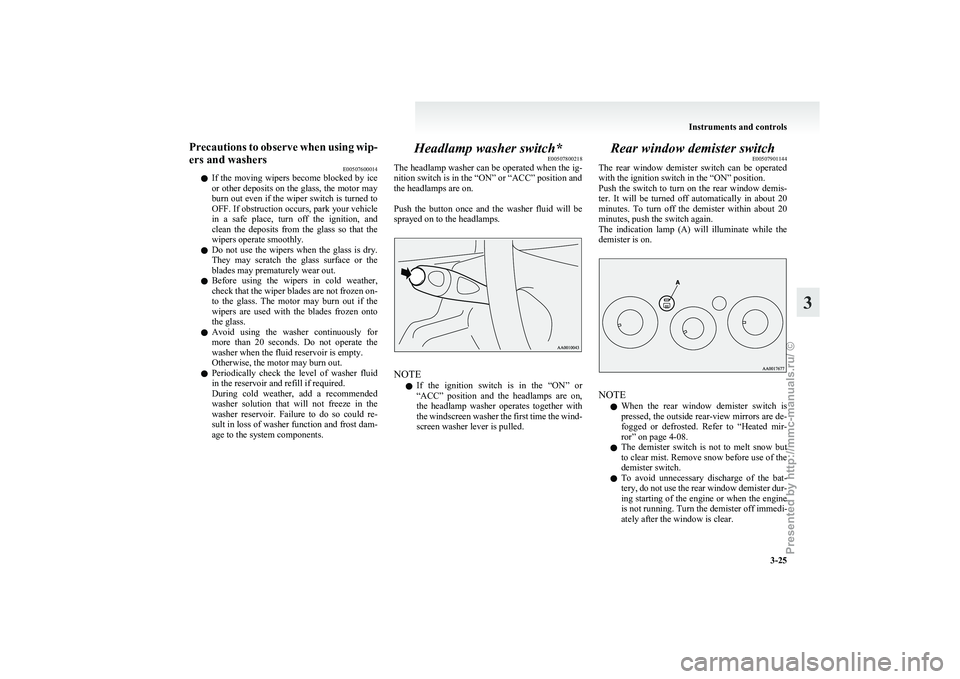
Precautions to observe when using wip-
ers and washers
E00507600014
l If
the moving wipers become blocked by ice
or other deposits on the glass, the motor may
burn out even if the wiper switch is turned to
OFF. If obstruction occurs, park your vehicle
in a safe place, turn off the ignition, and
clean the deposits from the glass so that the
wipers operate smoothly.
l Do not use the wipers when the glass is dry.
They may scratch the glass surface or the
blades may prematurely wear out.
l Before using the wipers in cold weather,
check that the wiper blades are not frozen on-
to the glass. The motor may burn out if the
wipers are used with the blades frozen onto
the glass.
l Avoid using the washer continuously for
more than 20 seconds. Do not operate the
washer when the fluid reservoir is empty.
Otherwise, the motor may burn out.
l Periodically check the level of washer fluid
in the reservoir and refill if required.
During cold weather, add a recommended
washer solution that will not freeze in the
washer reservoir. Failure to do so could re-
sult in loss of washer function and frost dam-
age to the system components. Headlamp washer switch*
E00507800218
The
headlamp washer can be operated when the ig-
nition switch is in the “ON” or “ACC” position and
the headlamps are on.
Push the button once and the washer fluid will be
sprayed on to the headlamps. NOTE
l If
the ignition switch is in the “ON” or
“ACC” position and the headlamps are on,
the headlamp washer operates together with
the windscreen washer the first time the wind-
screen washer lever is pulled. Rear window demister switch
E00507901144
The
rear window demister switch can be operated
with the ignition switch in the “ON” position.
Push the switch to turn on the rear window demis-
ter. It will be turned off automatically in about 20
minutes. To turn off the demister within about 20
minutes, push the switch again.
The indication lamp (A) will illuminate while the
demister is on. NOTE
l When
the rear window demister switch is
pressed, the outside rear-view mirrors are de-
fogged or defrosted. Refer to “Heated mir-
ror” on page 4-08.
l The demister switch is not to melt snow but
to clear mist. Remove snow before use of the
demister switch.
l To avoid unnecessary discharge of the bat-
tery, do not use the rear window demister dur-
ing starting of the engine or when the engine
is not running. Turn the demister off immedi-
ately after the window is clear. Instruments and controls
3-25 3
Presented by http://mmc-manuals.ru/ \251
Page 109 of 273

Steering wheel height adjustment
E00600700121
To
adjust the steering wheel height, release the tilt
lock lever while holding the steering wheel by
hand, and raise or lower the steering wheel to the
desired height.
After adjustment, securely lock the lever by pulling
it upward. 1- Locked
2-
Release WARNING
l After
adjusting to the desired height,
check to be sure that the lever is locked.
l Do not attempt to adjust the steering
wheel while you are driving the vehicle.
l When releasing the tilt lock lever, move it
to the release position (2) and hold the
steering wheel by hand to prevent it fall-
ing to the lowest position. Inside rear-view mirror
E00600800425
Adjust
the rear-view mirror only after making any
seat adjustments so you have a clear view to the
rear of the vehicle. WARNING
l Do
not attempt to adjust the rear-view
mirror while driving. This can be danger-
ous.
Always adjust the mirror before driving.
Adjust the rear-view mirror to maximize the view
through the rear window.
To adjust the vertical mirror position
It
is possible to move the mirror up and down to ad-
just its position. To reduce the glare
The
lever (A) at the bottom of the mirror can be
used to adjust the mirror to reduce the glare from
the headlamps of vehicles behind you during night
driving. 1- Normal
2-
Anti-glare Starting and driving
4-06
4
Presented by http://mmc-manuals.ru/ \251
Page 112 of 273
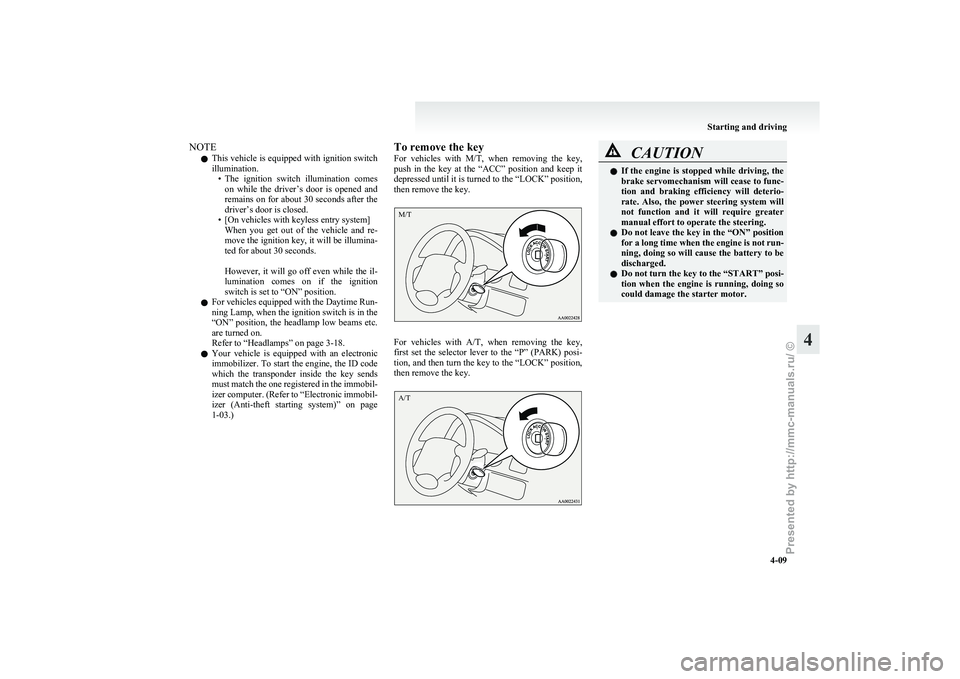
NOTE
l This
vehicle is equipped with ignition switch
illumination. • The ignition switch illumination comeson while the driver’s door is opened and
remains on for about 30 seconds after the
driver’s door is closed.
• [On vehicles with keyless entry system] When you get out of the vehicle and re-
move the ignition key, it will be illumina-
ted for about 30 seconds.
However, it will go off even while the il-
lumination comes on if the ignition
switch is set to “ON” position.
l For vehicles equipped with the Daytime Run-
ning Lamp, when the ignition switch is in the
“ON” position, the headlamp low beams etc.
are turned on.
Refer to “Headlamps” on page 3-18.
l Your vehicle is equipped with an electronic
immobilizer. To start the engine, the ID code
which the transponder inside the key sends
must match the one registered in the immobil-
izer computer. (Refer to “Electronic immobil-
izer (Anti-theft starting system)” on page
1-03.) To remove the key
For
vehicles with M/T, when removing the key,
push in the key at the “ACC” position and keep it
depressed until it is turned to the “LOCK” position,
then remove the key. For vehicles with A/T,
when removing the key,
first set the selector lever to the “P” (PARK) posi-
tion, and then turn the key to the “LOCK” position,
then remove the key. CAUTION
l
If
the engine is stopped while driving, the
brake servomechanism will cease to func-
tion and braking efficiency will deterio-
rate. Also, the power steering system will
not function and it will require greater
manual effort to operate the steering.
l Do not leave the key in the “ON” position
for a long time when the engine is not run-
ning, doing so will cause the battery to be
discharged.
l Do not turn the key to the “START” posi-
tion when the engine is running, doing so
could damage the starter motor. Starting and driving
4-09 4M/T A/T
Presented by http://mmc-manuals.ru/ \251
Page 217 of 273

Automatic transmission fluid*
E01000600857
The
proper amount of automatic transmission fluid
is essential to the life and operation of the automat-
ic transmission. Either insufficient fluid or exces-
sive fluid could cause transmission trouble. The
transmission fluid filler port cap is equipped with a
dipstick. Use the following procedure to check the
fluid level.
Procedure for checking the fluid level
1. Check the fluid level after the vehicle hasbeen driven enough to warm up the transmis-
sion fluid.
2. Park the vehicle on a flat, level surface and apply the parking brake.
3. With the engine idling and the brake pedal fully depressed, move the transmission selec-
tor lever through all the positions from P”
(PARK) to “D” (DRIVE), stopping momen-
tarily at each position.
4. Move the selector lever to the “P” (PARK) position.
5. Remove the dipstick and wipe it with a clean lint-free cloth.
6. Reinsert the dipstick as far as it goes. 7. Remove dipstick and read the oil level.
The fluid level should always be between the
two marks on the dipstick. WARNING
l Do
not spill the fluid onto a hot exhaust
manifold during topping up or inspec-
tion, or a fire may occur.
Fluid type
Use
only “DIA QUEEN ATF SP III” transmission
fluid to ensure optimum transmission performance. Washer fluid
E01000700164
Check
the float (A) is between the “FULL” and
“EMPTY” marks on the washer fluid reservoir.
If the level is low, replenish the container with wash-
er fluid. NOTE
l The
washer fluid container serves the wind-
screen, rear window and headlamps*.
During cold weather
To ensure proper operation of the washers at low
temperatures, use a fluid containing an anti-freez-
ing agent. Maintenance
8-08
8
Presented by http://mmc-manuals.ru/ \251
Page 231 of 273
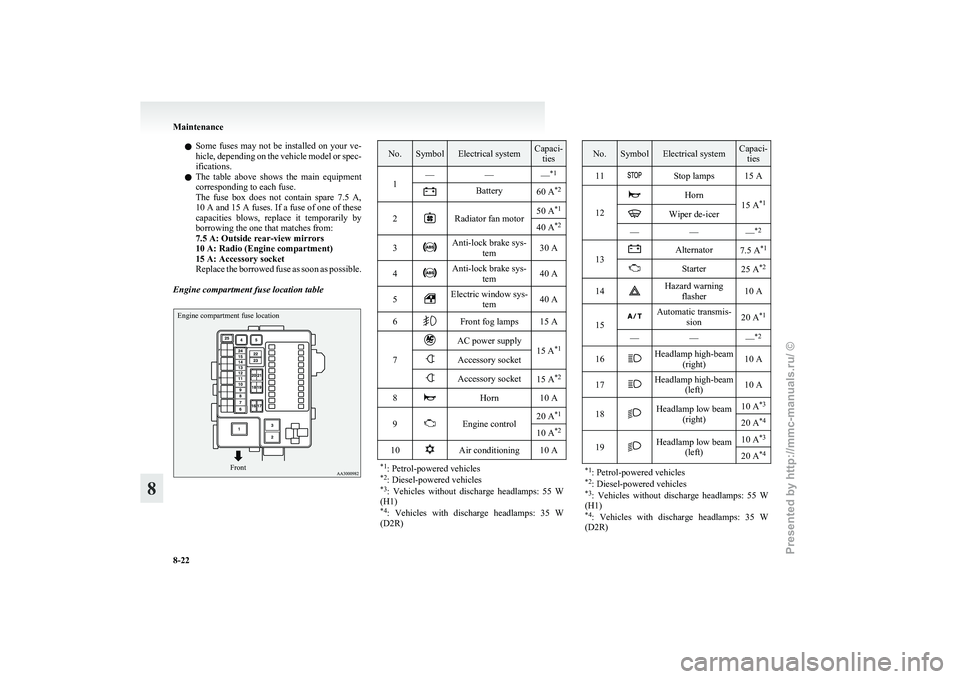
l
Some fuses may not be installed on your ve-
hicle, depending on the vehicle model or spec-
ifications.
l The table above shows the main equipment
corresponding to each fuse.
The fuse box does not contain spare 7.5 A,
10 A and 15 A fuses. If a fuse of one of these
capacities blows, replace it temporarily by
borrowing the one that matches from:
7.5 A: Outside rear-view mirrors
10 A: Radio (Engine compartment)
15 A: Accessory socket
Replace the borrowed fuse as soon as possible.
Engine compartment fuse location table
Engine compartment fuse location
Front No. Symbol Electrical system Capaci-
ties
1 —
—
—*1 Battery
60 A*2
2 Radiator fan motor
50 A
*1
40 A *2
3 Anti-lock brake sys-
tem 30 A
4 Anti-lock brake sys-
tem 40 A
5 Electric window sys-
tem 40 A
6 Front fog lamps 15 A
7 AC power supply
15 A*1 Accessory socket
Accessory socket
15 A*2
8 Horn 10 A
9 Engine control
20 A
*1
10 A *2
10 Air conditioning 10 A
*1 : Petrol-powered vehicles
*2 : Diesel-powered vehicles
*3 :
Vehicles without discharge headlamps: 55 W
(H1)
*4 : Vehicles with discharge headlamps: 35 W
(D2R) No. Symbol Electrical system Capaci-
ties
11 Stop lamps 15 A
12 Horn
15 A*1 Wiper de-icer
— —
—*2
13 Alternator
7.5 A*1 Starter
25 A*2
14 Hazard warning
flasher 10 A
15 Automatic transmis-
sion 20 A
*1
— —
—*2
16 Headlamp high-beam
(right) 10 A
17 Headlamp high-beam
(left) 10 A
18 Headlamp low beam
(right) 10 A
*3
20 A *4
19 Headlamp low beam
(left) 10 A
*3
20 A *4
*1 : Petrol-powered vehicles
*2 : Diesel-powered vehicles
*3 :
Vehicles without discharge headlamps: 55 W
(H1)
*4 : Vehicles with discharge headlamps: 35 W
(D2R) Maintenance
8-22
8
Presented by http://mmc-manuals.ru/ \251
Page 232 of 273
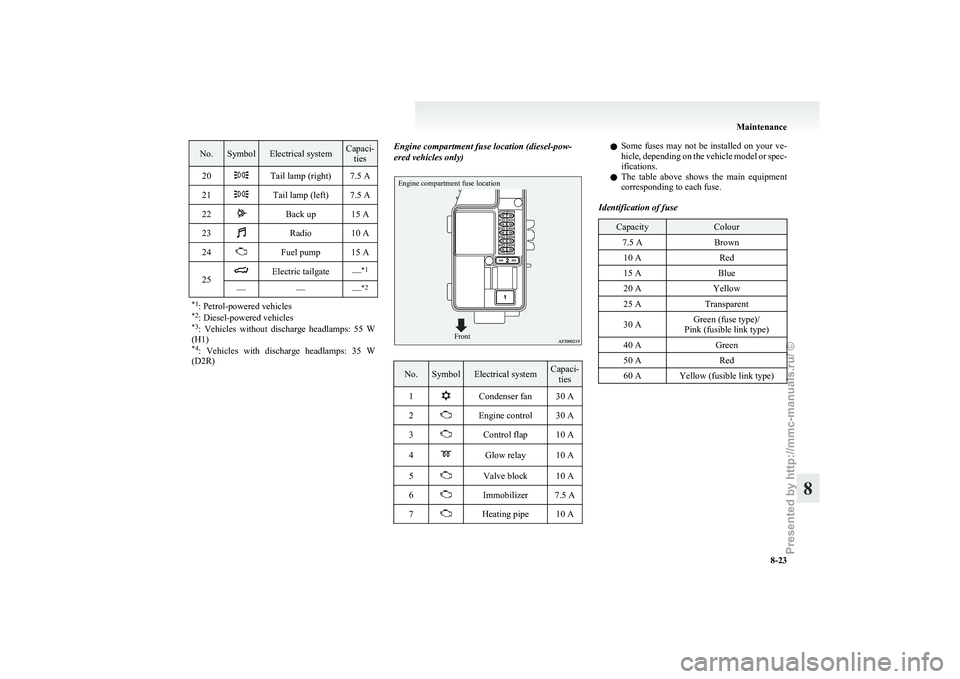
No. Symbol Electrical system Capaci-
ties
20 Tail lamp (right) 7.5 A
21 Tail lamp (left) 7.5 A
22 Back up 15 A
23 Radio 10 A
24 Fuel pump 15 A
25 Electric tailgate
—*1
— —
—*2
*1 : Petrol-powered vehicles
*2 : Diesel-powered vehicles
*3 :
Vehicles without discharge headlamps: 55 W
(H1)
*4 : Vehicles with discharge headlamps: 35 W
(D2R) Engine compartment fuse location (diesel-pow-
ered vehicles only)
Engine compartment fuse location
Front No. Symbol Electrical system Capaci-
ties
1 Condenser fan 30 A
2 Engine control 30 A
3 Control flap 10 A
4 Glow relay 10 A
5 Valve block 10 A
6 Immobilizer 7.5 A
7 Heating pipe 10 A l
Some
fuses may not be installed on your ve-
hicle, depending on the vehicle model or spec-
ifications.
l The table above shows the main equipment
corresponding to each fuse.
Identification of fuse Capacity Colour
7.5 A Brown
10 A Red
15 A Blue
20 A Yellow
25 A Transparent
30 A Green (fuse type)/
Pink (fusible link type)
40 A Green
50 A Red
60 A Yellow (fusible link type) Maintenance
8-23 8
Presented by http://mmc-manuals.ru/ \251
Page 234 of 273
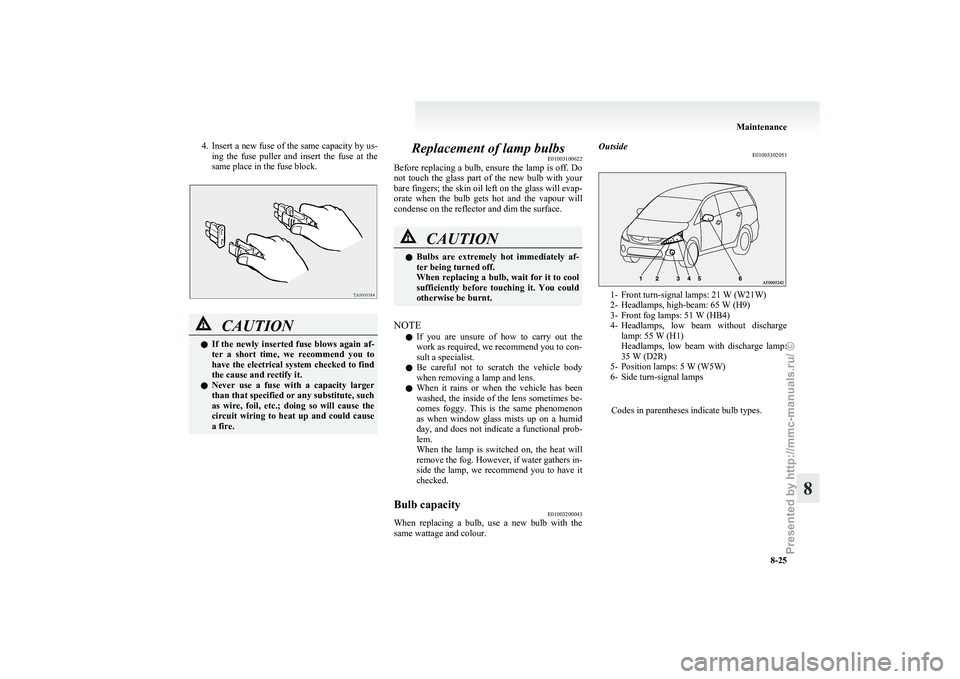
4. Insert a new fuse of the same capacity by us-
ing the fuse puller and insert the fuse at the
same place in the fuse block. CAUTION
l
If
the newly inserted fuse blows again af-
ter a short time, we recommend you to
have the electrical system checked to find
the cause and rectify it.
l Never use a fuse with a capacity larger
than that specified or any substitute, such
as wire, foil, etc.; doing so will cause the
circuit wiring to heat up and could cause
a fire. Replacement of lamp bulbs
E01003100622
Before
replacing a bulb, ensure the lamp is off. Do
not touch the glass part of the new bulb with your
bare fingers; the skin oil left on the glass will evap-
orate when the bulb gets hot and the vapour will
condense on the reflector and dim the surface. CAUTION
l
Bulbs
are extremely hot immediately af-
ter being turned off.
When replacing a bulb, wait for it to cool
sufficiently before touching it. You could
otherwise be burnt.
NOTE l If
you are unsure of how to carry out the
work as required, we recommend you to con-
sult a specialist.
l Be careful not to scratch the vehicle body
when removing a lamp and lens.
l When it rains or when the vehicle has been
washed, the inside of the lens sometimes be-
comes foggy. This is the same phenomenon
as when window glass mists up on a humid
day, and does not indicate a functional prob-
lem.
When the lamp is switched on, the heat will
remove the fog. However, if water gathers in-
side the lamp, we recommend you to have it
checked.
Bulb capacity E01003200043
When replacing a bulb, use a new bulb with the
same wattage and colour. Outside
E01003302051 1- Front turn-signal lamps: 21 W (W21W)
2-
Headlamps, high-beam: 65 W (H9)
3- Front fog lamps: 51 W (HB4)
4- Headlamps, low beam without discharge lamp: 55 W (H1)
Headlamps, low beam with discharge lamp:
35 W (D2R)
5- Position lamps: 5 W (W5W)
6- Side turn-signal lamps
Codes in parentheses indicate bulb types. Maintenance
8-25 8
Presented by http://mmc-manuals.ru/ \251
Page 235 of 273

1- High-mounted stop lamp
2-
Stop and tail lamps
3- Rear fog lamp (LHD vehicles): 21 W (W21W) Reversing lamp (RHD vehicles): 21 W
(W21W)
4- Licence plate lamps: 5 W (W5W)
5- Reversing lamp (LHD vehicles): 21 W (W21W)
Rear fog lamp (RHD vehicles): 21 W (W21W)
6- Rear turn-signal lamps: 21 W (WY21W)
Codes in parentheses indicate bulb types.
NOTE l The side turn-signal lamps, stop and tail
lamps and high-mounted stop lamp use
LEDs rather than bulbs. For repair and re-
placement, we recommend you to consult a
specialist. Inside
E01003400986 1- Rear personal lamps: 8 W
2-
Room lamp & map lamps: 8 W
3- Vanity mirror lamps*: 3 W
4- Glove box lamp: 1.4 W
5- Door lamps: 3.4 W
6- Luggage compartment lamp: 5 W Headlamps
E01003501290
Replacement of low beam (except for vehicles
with discharge headlamps) 1. Pull
out the connector (B) while pressing the
tab (A). Turn the cap (C) anticlockwise and
remove it. 2. Pull the socket (D) off the bulb.Maintenance
8-26
8
Presented by http://mmc-manuals.ru/ \251
Page 236 of 273

3. Unhook the spring (E), which secures the
bulb, and remove the bulb. 4. To
install the bulb, perform the removal
steps in reverse. CAUTION
l
Handle
halogen lamp bulbs with care.
The gas inside halogen lamp bulbs is high-
ly pressurized, so dropping, knocking, or
scratching a halogen lamp bulb can cause
it to shatter.
l Never hold the halogen lamp bulb with a
bare hand, dirty glove, etc.
The oil from your hand could cause the
bulb to break the next time the head-
lamps are operated.
If the glass surface is dirty, it must be
cleaned with alcohol, paint thinner, etc.,
and refit it after drying it thoroughly. Replacement of low beam (for vehicles with dis-
charge headlamps)
Do
not attempt to disassemble or repair discharged
headlamps, and do not attempt to replace their bulbs. CAUTION
l
A high voltage is present in the power cir-
cuit
and in the bulbs and bulb terminals.
To avoid the risk of an electric shock, con-
tact a MITSUBISHI MOTORS Author-
ized Service Point whenever repair or re-
placement is necessary. Replacement of high-beam
1. For
diesel-powered vehicles, remove the
bolts (A) to remove the power steering reser-
voir tank (B). 2. Pull
out the connector (D) while pressing the
tab (C). Turn the cap (E) anticlockwise and
remove it. Maintenance
8-27 8
Presented by http://mmc-manuals.ru/ \251
Page 260 of 273
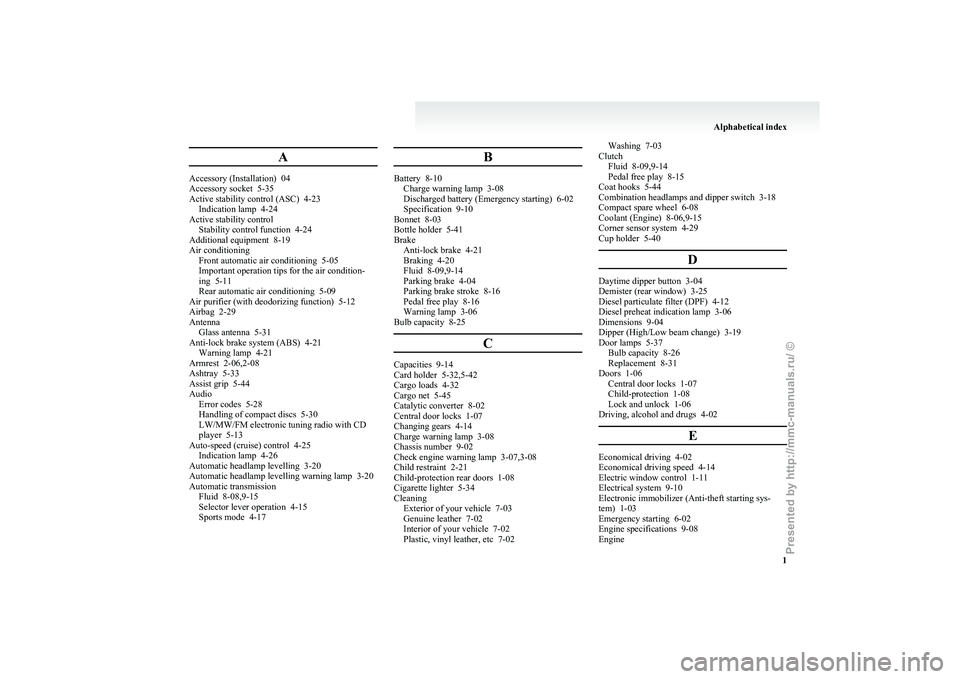
A
Accessory (Installation) 04
Accessory socket 5-35
Active stability control (ASC)
4-23
Indication lamp 4-24
Active stability control Stability control function 4-24
Additional equipment 8-19
Air conditioning Front automatic air conditioning 5-05
Important operation tips for the air condition-
ing 5-11
Rear automatic air conditioning 5-09
Air purifier (with deodorizing function) 5-12
Airbag 2-29
Antenna Glass antenna 5-31
Anti-lock brake system (ABS) 4-21 Warning lamp 4-21
Armrest 2-06,2-08
Ashtray 5-33
Assist grip 5-44
Audio Error codes 5-28
Handling of compact discs 5-30
LW/MW/FM electronic tuning radio with CD
player 5-13
Auto-speed (cruise) control 4-25 Indication lamp 4-26
Automatic headlamp levelling 3-20
Automatic headlamp levelling warning lamp 3-20
Automatic transmission Fluid 8-08,9-15
Selector lever operation 4-15
Sports mode 4-17 BBattery 8-10
Charge warning lamp 3-08
Discharged battery (Emergency starting)
6-02
Specification 9-10
Bonnet 8-03
Bottle holder 5-41
Brake Anti-lock brake 4-21
Braking 4-20
Fluid 8-09,9-14
Parking brake 4-04
Parking brake stroke 8-16
Pedal free play 8-16
Warning lamp 3-06
Bulb capacity 8-25
C Capacities 9-14
Card holder 5-32,5-42
Cargo loads 4-32
Cargo net 5-45
Catalytic converter
8-02
Central door locks 1-07
Changing gears 4-14
Charge warning lamp 3-08
Chassis number 9-02
Check engine warning lamp 3-07,3-08
Child restraint 2-21
Child-protection rear doors 1-08
Cigarette lighter 5-34
Cleaning Exterior of your vehicle 7-03
Genuine leather 7-02
Interior of your vehicle 7-02
Plastic, vinyl leather, etc 7-02 Washing 7-03
Clutch Fluid 8-09,9-14
Pedal free play 8-15
Coat hooks 5-44
Combination headlamps and dipper switch
3-18
Compact spare wheel 6-08
Coolant (Engine) 8-06,9-15
Corner sensor system 4-29
Cup holder 5-40
D Daytime dipper button 3-04
Demister (rear window) 3-25
Diesel particulate filter (DPF)
4-12
Diesel preheat indication lamp 3-06
Dimensions 9-04
Dipper (High/Low beam change) 3-19
Door lamps 5-37 Bulb capacity 8-26
Replacement 8-31
Doors 1-06 Central door locks 1-07
Child-protection 1-08
Lock and unlock 1-06
Driving, alcohol and drugs 4-02
E Economical driving 4-02
Economical driving speed
4-14
Electric window control 1-11
Electrical system 9-10
Electronic immobilizer (Anti-theft starting sys-
tem) 1-03
Emergency starting 6-02
Engine specifications 9-08
Engine Alphabetical index
1
Presented by http://mmc-manuals.ru/ \251